As the crisis caused by the Covid-19 pandemic is being overcome, automation as a service is going to lead us to a new reality thanks to technologies such as the Internet of Things (IOT), artificial intelligence (AI) and Blockchain. A new digital era, focused on human interoperability, where truth verification platforms, as facilitated by Blockchain technology, will constitute the new operating system of the City-Port 5.0 relationship. Its background is explained in the following section.
Background of the City-Port 5.0
These antecedents are smart ports and cities and the recent concepts and developments of Society 5.0, City 5.0, and Marketing 5.0.
Ports and Smart Cities
With sensors and intelligence devices, we can share data in real time, modifying business models and the management of supply chain operations. This leads to digitization and automation, with the result of increasing yields. These two factors have changed logistics, with the dematerialization of data eliminating the costly chain of physical documents, while automation is increasing the level of security and efficiency.
In this scenario, the main logistics nodes represented by seaports and dry ports are changing their rules and business models from being considered simply “Industrial or Logistics Centers” to an evolved concept of “Smart Digital Ports”, based on digital platforms and IoT devices capable of capturing and sharing data in real time, as shown in the following image [1].
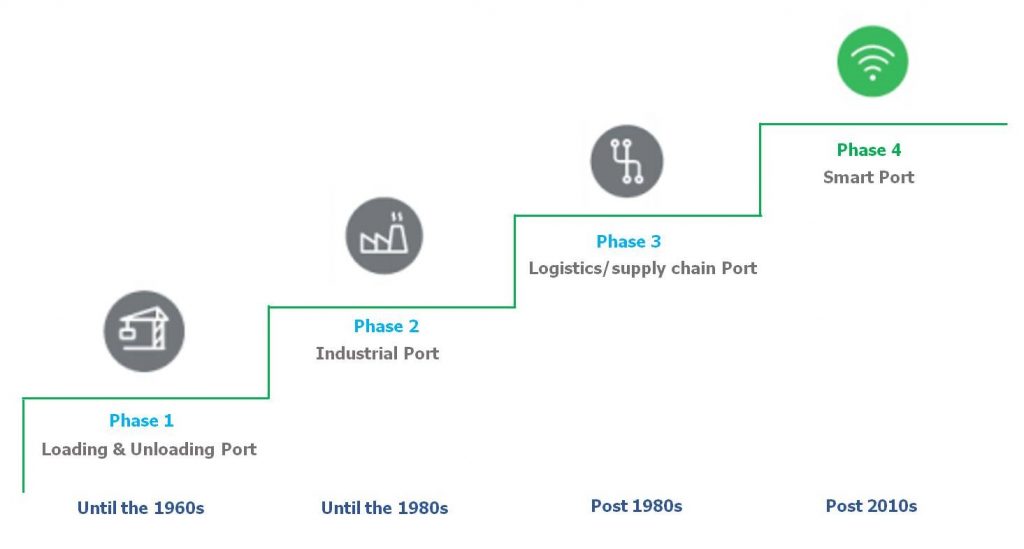
In the concept of smart cities, the Internet of Things (IoT) is a key technical element, as it enables sensors, software and communication functions to cooperate with other connected devices.
This makes it possible for sensors to provide data that will be used to act on their environment, e.g. equipping garbage bins with weight sensors allows collection to be performed only when necessary, reducing garbage truck trips, which reduces traffic, pollution and personnel costs.
The concepts of Society 5.0, City 5.0 and Marketing 5.0
The concept of Society 5.0 has been developed mainly in Japan, defining an ideal situation towards which each country should evolve in order to take full advantage of continuous technology with transformations, thus benefiting all its citizens.
Society 5.0 aims to solve social problems from a new perspective. In this new era, different aspects would be connected and technologies would join a super smart society with full integration from Big Data, Internet of Things (IoT), Artificial Intelligence (AI), Blockchain and services to people to facilitate digital and physical infrastructures for humans.
In the following image we see the evolution of the different industrial revolutions. Industry 4.0 stands out for the speed of disruptive changes in cyber-physical systems, smart industry, big data and IoT. The development of different industrial revolutions is related to the concept of Society 5.0. In the current period of human history, future technological advances are driven by an approach where the well-being of all humans predominates [2].
During the transition from one society to another, changes occur at all social levels; therefore, social change usually follows industrial revolutions, as shown in the image.
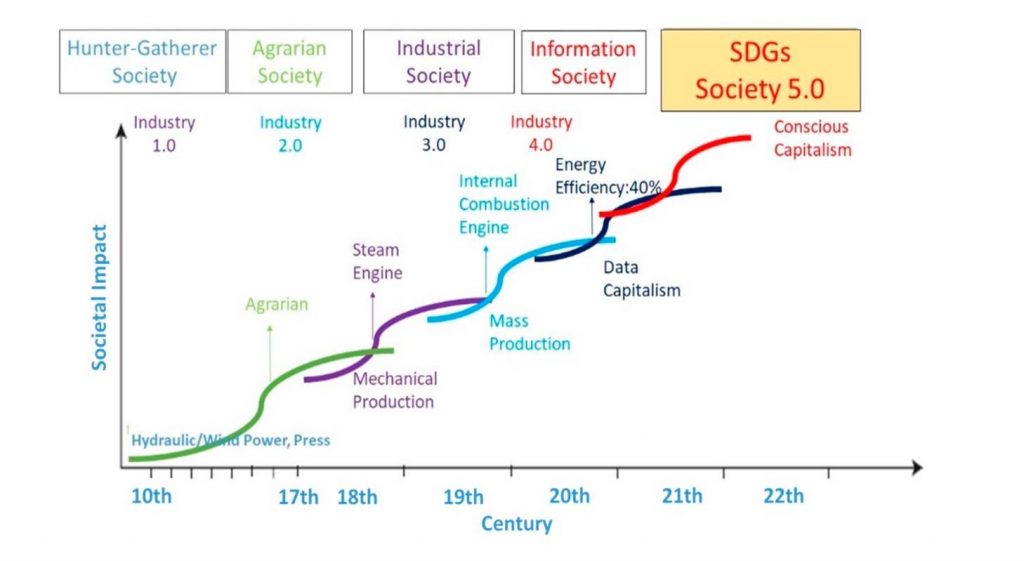
From Rosemann’s analysis [3] City 5.0 is defined as “a livable city that is (re)modeled with the goal of removing constraints for its citizens, by using digitalization for the provision of public goods and services“.
The underlying hypothesis is that a city without restrictions in the provision of public goods and services becomes a livable city because it is inclusive and frictionless. The notion of “livability” describes the overall contribution of the urban environment to the quality of life and well-being of its residents. Digital technologies offer important possibilities to overcome established constraints, but technologies alone would not be enough [3].
The paradigm shift towards a City 5.0 is not an alternative way to ensure the integration of ethical and sustainability issues in the context of creating robust and resilient societies in the digitized world, but a platform for these ideas to flourish and be put into practice.
Marketing 5.0, by definition [4], is the application of technologies that mimic humans to create, communicate, deliver and enhance value throughout the customer journey. One of the fundamental themes of marketing 5.0 is a group of technologies that aim to emulate the capabilities of human marketers and combine to enable a marketing 5.0 approach: artificial intelligence, PLN, sensors, robotics, augmented reality (AR), virtual reality (VR), internet of things, blockchain.
For many years, artificial intelligence has been developed to replicate human cognitive capabilities, especially to learn from unstructured customer data and discover beneficial insights for marketers. When combined with other technologies, AI can also be used to provide suitable offers to suitable customers; thanks to big data-based analytics, marketers can personalize their strategy, a process known as “one-to-one marketing”, which is now a widespread practice [4].
The goal is to create a new customer experience (CX), see the following image, frictionless and compelling [4].
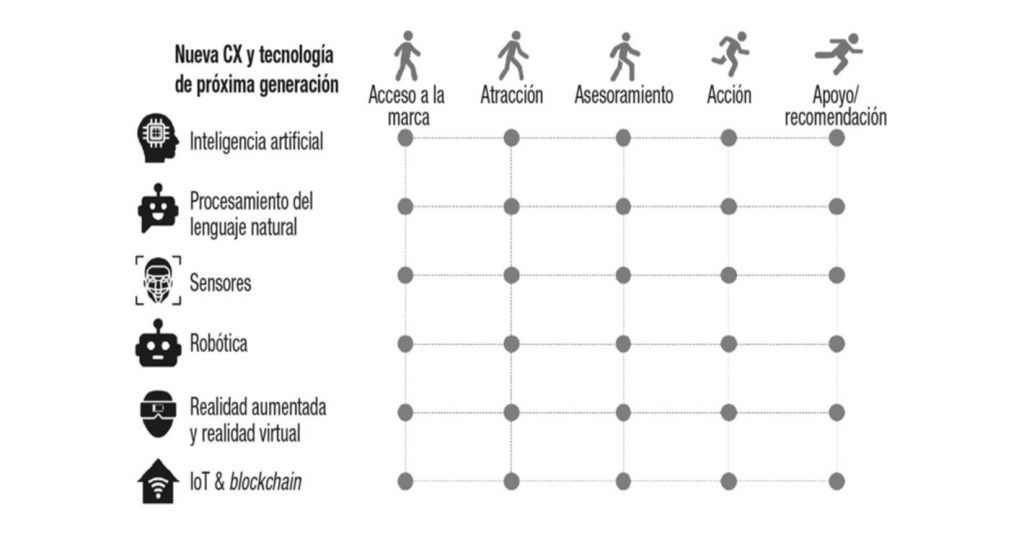
From information to the importance of truth in the City-Port for inclusion
Thanks to neuroscience research, we know that the most basic human need is for social connection, which is more motivating than food, water, and shelter. Neuroscientists have also discovered that the human brain is capable of combining data from multiple sources of sensory information to plan future courses of action and handle unexpected and novel situations [5].
At the same time, the well-known physicist Wheeler has concluded that information is as important as energy and matter, if not more so. The ontological priority of information was summarized in his famous expression “it from bit”.
According to quantum theory, before an observation is made, the atomic particle exists in superposition of states. Once observed, the particle collapses instantaneously into one position, suggesting that reality is created by observers; no phenomenon is real until it is observed [6].
Wheeler’s anthropic participatory principle states that the universe requires observers, because without them it would not exist. Things are in fact information. But information itself is quantum information, in that it is no longer simply, for example, noise or information, but the coexistence of truth and falsity at the same time, said in elementary language: it (comes) from bit (comes) from qubit.
This leads us in the field of cities and ports, because of their human ecosystem of complex relationships, to the importance of verifying certainties (truths), to build trust, and to improve collaboration as a source of progress and growth.
There are three steps to productive collaboration. Building trust cultivates purpose and purpose generates energy, so that people become productive and engaged collaborators [7], as shown in the image on the left.
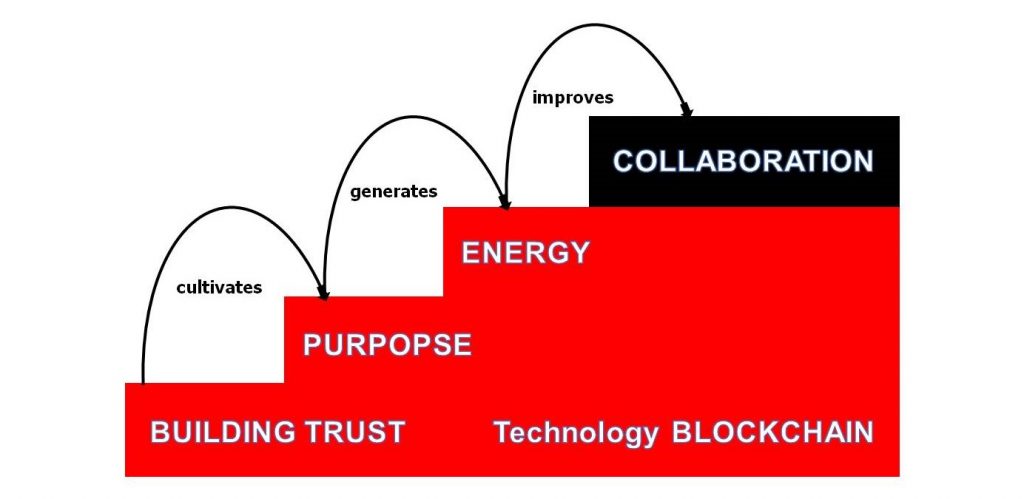
The conceptual evolutionary process of cities and ports has gone throughout history from being excluded spaces, delimiting their separation, to later being integrated and finally allowing with the current process of digitalization and automation, their inclusion, see the image on the left, and human sustainability, thanks to IOT, AI, and Blockchain technologies.
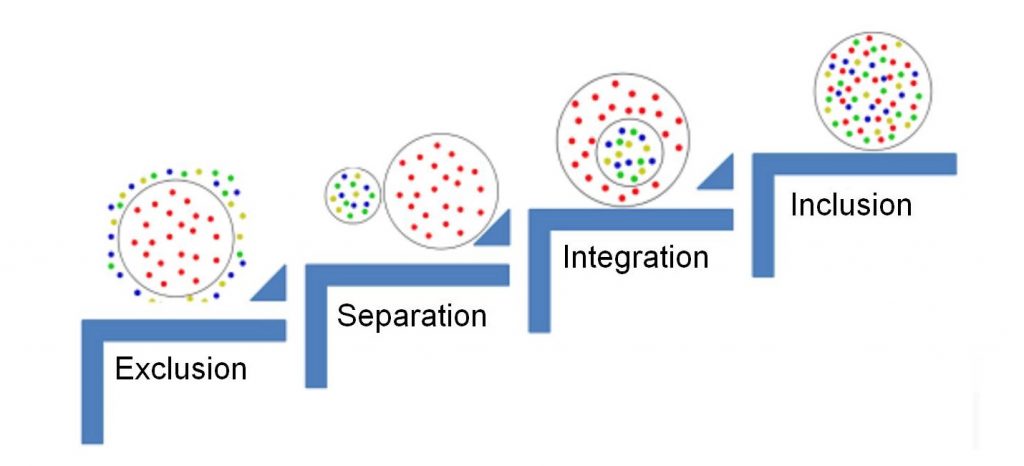
The City-Port 5.0 model corresponds to inclusive sustainability, centered on the human being, who has virtual access, with mobile devices, to communicate, interact and make decisions, in all aspects of urban and port activity.
Blockchain as the operating system of the City-Port 5.0 model
Blockchain technology is based on records made in a distributed and decentralized manner, which guarantee, due to their collaborative and consensual design, that they are immutable.
With Blockchain, once the algorithms involved in the transactions and records to be managed have been defined, there is no need for intermediaries and other processes such as transaction auditing or task automation, which previously required the intervention of an intermediary, are facilitated. Smart Contracts, for example, one of the Blockchain application examples, are automatically generated and signed if the conditions defined in the processes are met without the need for verification by an intermediary entity, see the following image.
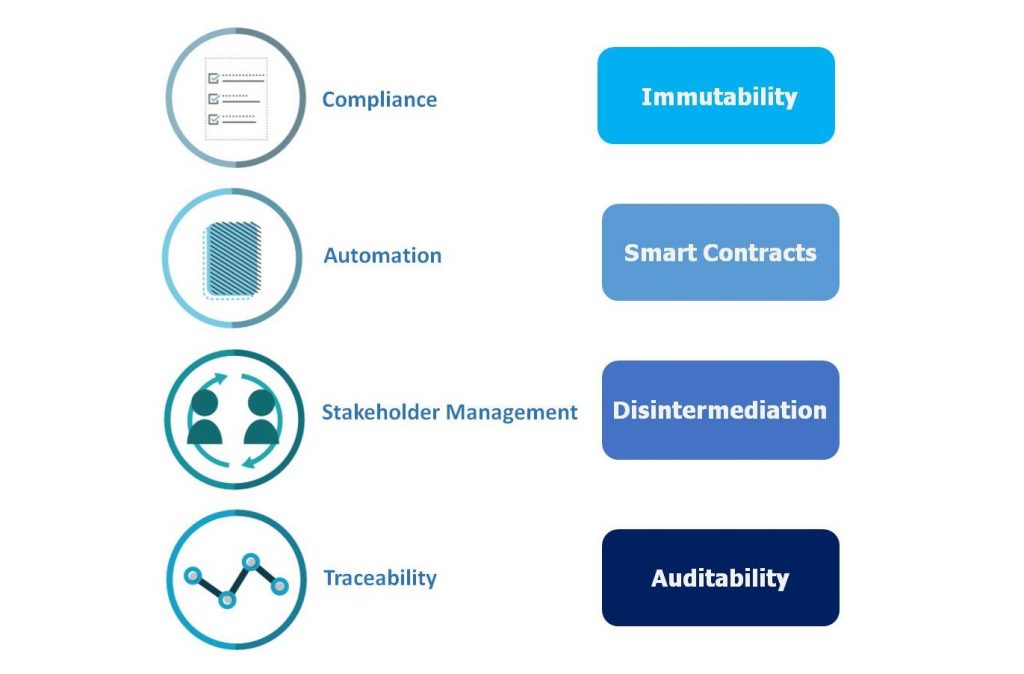
It is essential to recognize that the adoption of a disruptive technology such as Blockchain could potentially change existing business models and the way cities and ports and logistics chains work.
The transformative impacts of Blockchain could cascade from the citizen level to structural changes in the governance of cities, ports, etc.
It must be recognized that Blockchain technology is not without limitations, with four main barriers against Blockchain adoption having been identified, which are inter-organizational, intra-organizational, technical and external barriers [8]. For Blockchain to realize its expectations and achieve its goals and potential, a number of obstacles and challenges need to be addressed, as shown in the image.
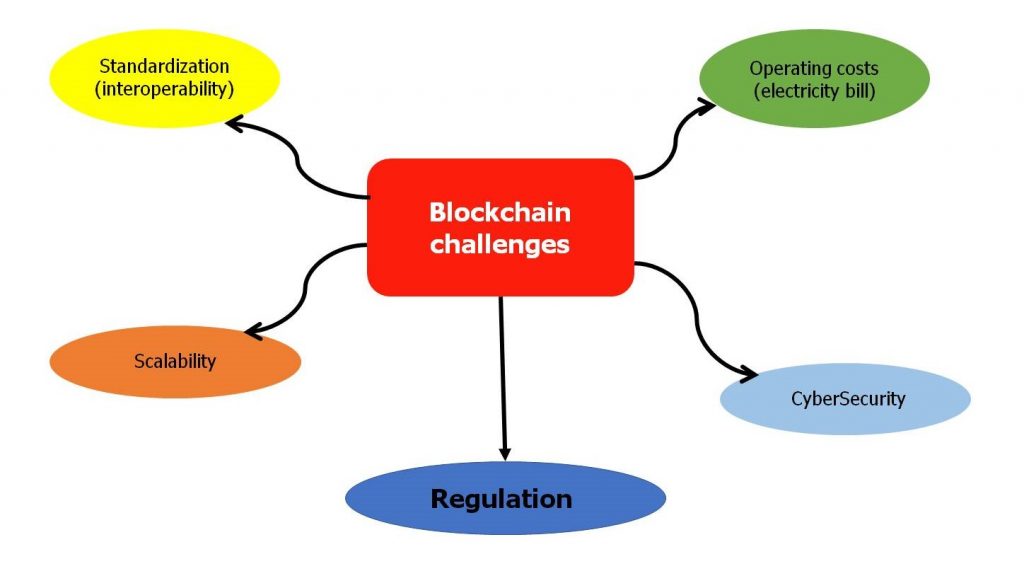
Inclusive sustainability and Stakeholders, keys to the City-Port 5.0
Sustainability is not a property of objects, but of systems, and to design truly sustainable solutions we need to take the whole system into account when making these decisions [9].
To achieve a sustainable future, ports and cities will have to cooperate with the quadruple helix, the “stakeholders representing key local actors from government, scientific and research institutions, businesses and citizens” (Igi-global.com, 2020).
They are often isolated from each other in terms of organizational and power relationships, and lack cooperation due to geography, different digital standards or digital platforms. These silos need to be removed to facilitate digital innovation and promote collaboration.
Digital transformation will require an inclusive governance process that builds trust through transparency in cities and ports.
This is only possible with real-time verification, as Blockchain technology allows us to do.
The connected citizen, integrated with the city-port environment through advanced technologies and platforms of verification networks of certainties or truths, Blockchain platforms, is key to the digital transformation, accessing networked data collected by the city and the port serving to improve services in their decision making.
The ITU (www.itu.int) in its recommendation for smart port-city interoperation, identifies requirements for the smart port platform to interoperate with smart city platforms and other smart elements in the environment where the port is located [10].
The inclusive sustainability City-Port 5.0 coincides with the IACP Agenda 2030, in accordance with the United Nations Sustainable Development Goals, and is structured in 10 objectives, specifically adapted to the context in which port agents and communities are inserted, gathering the areas of action on which port agents can really act effectively, as shown in the image.
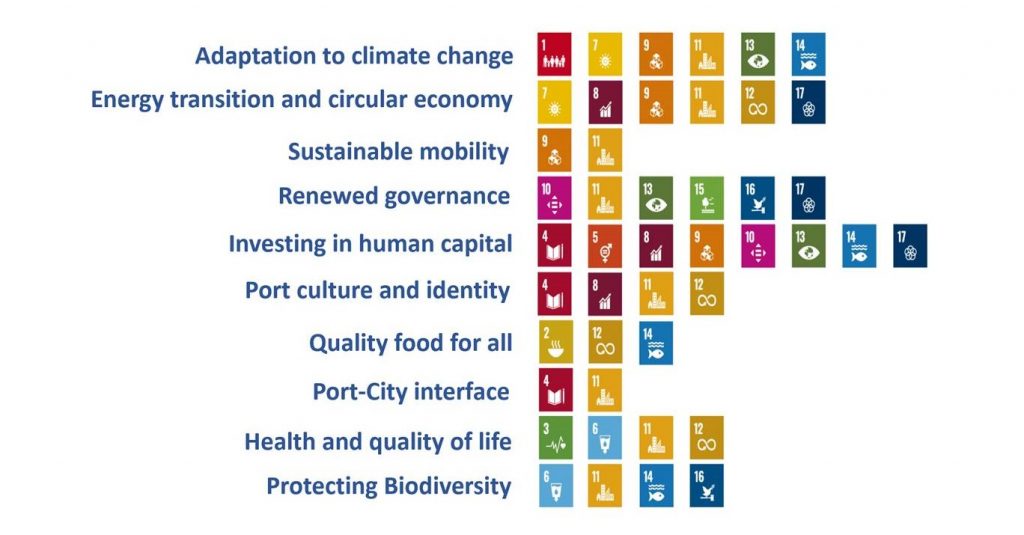
AIVP has developed the Port Centers to offer the public, initiated or not, the possibility to discover, experience and better understand contemporary port activities. This is possible thanks to a dedicated exhibition and various educational activities, as well as the organization of on-site visits to the port area. A space open to the general public can cover topics such as industrial port activities, transported goods, international trade, port professions and even the integration of the port in its city, among many others [11].
Public interest technology, citizen assemblies and governance with results
Technology in the public interest (TIP), commonly defined as “the deployment of technological knowledge in the service of the common good, often focused on under-resourced communities and needs”, based on IOT, AI, and Blockchain can facilitate for the City-Port 5.0 relationship governance with efficient, effective, and high performance outcomes.
Participatory sensing (PS) transforms IOT into an Internet of People by enabling citizens to network and share sensor data from their personal smartphones [12].
Participatory sensing has the potential to involve and engage local communities in collecting and sharing data about their environment, with the goal of addressing relevant challenges (e.g., traffic emissions), while enabling community members to make informed decisions about their daily routines (e.g., route or mode of transportation).
Head Image | Aerial view of the City and Port of Santander. (Source: Port Authority of Santander).
Notes
[2] Carolina Narvaez Rojas et al., (2021), “Society 5.0: A Japanese Concept for a Superintelligent Society” in Sustainability journal, 13, 6567, MDPI.
[3] Michael Rosemann, et al., (2021),” City 5.0”, in Bus Inf Syst Eng 63(1):71–77).
[4] Philip Kotler et al., (2021),”Marketing 5.0. Tecnología para la Humanidad”, LID.
[5] Nonaka & Takeuchi (Fall 2021),”Strategy as a way of life”, MIT Sloan.
[6] Vicente Cajal (2020),”Universo cuántico y sincronicidad”, Del Medico Editore(LT) Italy.
[7] Rob Cross, et al.,” A Noble Purpose Alone Won’t Transform Your Company”, MIT Sloan Management Review, Vol. 61, No. 2, winter 2020.
[8] Saeed Asadi Bagloee, et al., (2020), “Blockchain: The operating system of smart cities”, The International Journal of Urban Policy and Planning, Volume 112.
[9] Katherine Harrison, et al., (September 2021),” Sustainability Means Inclusivity: Engaging Citizens in Early-Stage Smart City Development”, IEEE Magazine.
[10] UIT-T Y.4209 (04/2020), “Requirements for interoperation of the smart port with the smart city”.
[11] Terje Rygh , et al., (2021), “Connecting Cities and Ports via Maritime Informatics”. Maritime Informatics. Springer 2021.
[12] AIVP (2019), “Agenda 2030. 10 goals for sustainable ports cities”.
Ciudad-Puerto 5.0: La nueva era de la digitalización y la automatización
A medida que se va superando la crisis provocada por la pandemia del Covid-19, la automatización como servicio, nos va a llevar a una nueva realidad gracias a tecnologías como el Internet de las Cosas (IOT), la inteligencia artificial (AI) y el Blockchain. Una nueva era digital, centrada en la interoperabilidad humana, donde las plataformas de verificación de la verdad, como facilita la tecnología Blockchain, constituirán el nuevo sistema operativo de la relación Ciudad-Puerto 5.0. A continuación se explican sus antecedentes en el siguiente apartado.
Antecedentes de la Ciudad-Puerto 5.0
Estos antecedentes, lo constituyen los puertos y ciudades inteligentes (Smart) y los conceptos y desarrollos recientes de Sociedad 5.0, Ciudad 5.0, y Marketing 5.0.
Puertos y Ciudades inteligentes
Con sensores y dispositivos de inteligencia podemos compartir datos en tiempo real, modificando los modelos de negocio y la gestión de las operaciones de la cadena de suministro. Lo que nos lleva a digitalización y automatización, con el resultado de aumentar los rendimientos. Estos dos factores han cambiado la logística, con la desmaterialización de los datos se eliminan la costosa cadena de documentos físicos, mientras que con la automatización se está aumentado el nivel de seguridad y eficiencia.
En este escenario, los principales nodos logísticos, representados por los puertos marítimos y los puertos secos, están cambiando sus reglas y modelos de negocio pasando de ser considerados simplemente “Centros Industriales o Logísticos” a un concepto evolucionado de “Puertos Digitales Inteligentes”, basados en plataformas digitales y dispositivos IoT capaces de captar y compartir datos en tiempo real, según se muestra en la siguiente imagen [1].
Evolución del desarrollo portuario. (Fuente: www.onthemosway.eu/the-evolution-of-port-system-from-industrial-to-a-smart-digital-area/?cn-reloaded=1/).
En el concepto de ciudades inteligentes, el Internet de las Cosas (IoT) es un elemento técnico clave, ya que permite que los sensores, el software y las funciones de comunicación cooperen con otros dispositivos conectados.
Esto hace posible que los sensores proporcionen datos que se utilizarán para actuar sobre su entorno, por ejemplo, equipar los cubos de basura con sensores de peso permite que la recogida se realice solo cuando sea necesario, reduciendo los viajes de los camiones de basura, lo que reduce el tráfico, la contaminación y la costes de personal.
Los conceptos de Sociedad 5.0, Ciudad 5.0 y Marketing 5.0
El concepto de Sociedad 5.0 se ha desarrollado principalmente en Japón, definiendo una situación ideal hacia el que cada país debería evolucionar para aprovechar plenamente la tecnología continua con transformaciones, beneficiando así a todos sus ciudadanos.
La Sociedad 5.0 pretende resolver los problemas sociales desde una nueva perspectiva. En esta nueva era, diferentes aspectos estarían conectados y las tecnologías se unirían a una sociedad superinteligente con una integración total desde el Big Data, el Internet de las cosas (IoT), la Inteligencia Artificial (IA), Blockchain y los servicios a las personas para facilitar las infraestructuras digitales y físicas para los seres humanos.
En la siguiente imagen vemos la evolución de las diferentes revoluciones industriales. La Industria 4.0 resalta por la velocidad de los cambios disruptivos de los sistemas ciberfísicos, la industria inteligente, el big data y el IoT. El desarrollo de las diferentes revoluciones industriales está relacionado con el concepto de Sociedad 5.0. En el periodo actual de la historia de la humanidad, los futuros avances tecnológicos se dirigen por un enfoque donde predomina el bienestar de todos los humanos [2].
Durante la transición de una sociedad a otra, se producen cambios en todos los niveles sociales; por ello, el cambio social suele ser posterior a las revoluciones industriales, como se como se muestra en la imagen.
Proceso evolutivo hacia la Sociedad 5.0. (Fuente: www.mdpi.com/2071-1050/13/12/6567).
Desde el análisis de Rosemann [3] la Ciudad 5.0 se define como ”una ciudad habitable que se (re)modela con el objetivo de eliminar las restricciones para sus ciudadanos, mediante el uso de la digitalización para el suministro de bienes y servicios públicos”.
La hipótesis subyacente es que una ciudad sin restricciones en el suministro de bienes y servicios públicos se convierte en una ciudad habitable, ya que es inclusiva y libre de fricciones. La noción de “habitabilidad”, describe la contribución global del entorno urbano a la calidad de vida y el bienestar de sus residentes. Las tecnologías digitales ofrecen importantes posibilidades para superar las restricciones establecidas, pero las tecnologías por sí solas no serían suficientes [3].
El cambio de paradigma hacia una Ciudad 5.0 no es una forma alternativa de garantizar la integración de las cuestiones éticas y de sostenibilidad en el contexto de la creación de sociedades robustas y resilientes en el mundo digitalizado, sino una plataforma para que estas ideas florezcan y se pongan en práctica.
El marketing 5.0, por definición [4], es la aplicación de tecnologías que imitan al ser humano para crear, comunicar, ofrecer y mejorar el valor a lo largo del recorrido del cliente. Uno de los temas fundamentales del marketing 5.0 es un grupo de tecnologías que pretenden emular las capacidades de los profesionales del marketing humano y que se combinan para permitir un enfoque de marketing 5.0: inteligencia artificial, PLN, sensores, robótica, realidad aumentada (RA), realidad virtual (RV), internet de las cosas, blockchain.
Durante muchos años, la inteligencia artificial se ha desarrollado para replicar las capacidades cognitivas humanas, especialmente para aprender de datos no estructurados de los clientes y descubrir ideas beneficiosas para los vendedores. Cuando se combina con otras tecnologías, la IA también puede utilizarse para proporcionar ofertas adecuadas a clientes adecuados; gracias a un análisis basado en big data, los profesionales del marketing pueden personalizar su estrategia, un proceso conocido como «marketing uno a uno», que en la actualidad es una práctica muy generalizada [4].
El objetivo es crear una nueva experiencia cliente (CX), ver la siguiente imagen, sin fricciones y convincente [4].
Tecnología de futuro aplicada a la nueva Experiencia Cliente. (Fuente: Philip Kotler et al., 2021, ”Marketing 5.0. Tecnología para la Humanidad”, LID).
De la información a la importancia de la verdad en la Ciudad-Puerto para su inclusión
Gracias a la investigación neurocientífica sabemos que la necesidad más básica de los humanos es la conexión social, que tiene mayor motivación que la comida, el agua y el cobijo. Los neurocientíficos también han descubierto que el cerebro humano es capaz de combinar datos de múltiples fuentes de información sensorial para planificar futuros cursos de acción y manejar situaciones inesperadas y novedosas [5].
A la vez, el conocido físico Wheeler ha llegado a la conclusión de que la información, es tan importante como la energía y la materia, si no más. La prioridad ontológica de la información se resumió en su famosa expresión “it from bit”.
De acuerdo con la teoría cuántica, antes de que se realice una observación, la partícula atómica existe en superposición de estados. Una vez observada, la partícula colapsa instantáneamente en una posición, lo que sugiere que la realidad es creada por los observadores; ningún fenómeno es real hasta que no es observado [6].
El principio antrópico participativo, de Wheeler declara que el universo requiere observadores, porque sin ellos no existiría. Las cosas son en realidad información. Pero la información misma es información cuántica, en cuanto que ya no se trata sencillamente, por ejemplo de ruido o información, sino de la coexistencia entre verdad y falsedad al mismo tiempo, dicho en un lenguaje elemental: it (comes) from bit (comes) from qubit.
Los tres escalones, desde la confianza a la colaboración. (Fuente: Rob Cross, et al.,” A Noble Purpose Alone Won’t Transform Your Company”, MIT Sloan Management Review, Vol. 61, No. 2, winter 2020).
El proceso conceptual evolutivo de las ciudades y los puertos ha pasado a lo largo de la historia de ser espacios excluidos, delimitando su separación, para posteriormente integrarse y finalmente permitir con el proceso actual de digitalización y automatización, su inclusión, ver la siguiente imagen, y sostenibilidad humana, gracias a las tecnologías IOT, IA, y Blockchain.
Proceso conceptual evolutivo Ciudad-Puerto, hacia a la inclusión virtual. (Fuente: https//erika-jamerson.medium.com/what-is-inclusive-education-e94849601038/).
El modelo Ciudad-Puerto 5.0 se corresponde con la sostenibilidad inclusiva, centrada en el ser humano, que dispone del acceso virtual, con dispositivos móviles, para comunicarse, relacionarse y tomar decisiones, en todos los aspectos de la actividad urbana y portuaria.
Blockchain como el sistema operativo del modelo Ciudad-Puerto 5.0
La tecnología Blockchain se basa en los registros realizados de forma distribuida y descentralizada, que garantizan, por su diseño colaborativo y consensuado, que sean inmutables.
Con Blockchain, una vez definidos los algoritmos que intervienen en las transacciones y registros que se desean gestionar, no se necesitan intermediarios y se facilitan otros procesos como los de auditoría de operaciones o la automatización de tareas, que antes precisaban de la intervención de la figura del intermediario. Los Smart Contracts, por ejemplo, uno de los ejemplos de aplicación de Blockchain, se generan y firman automáticamente si se dan las condiciones definidas en los procesos sin que se necesite la comprobación de una entidad intermediaria, ver la imagen.
Puntos débiles y capacidades del Blockchain como solución a las cadenas logísticas. (Fuente: www2.deloitte.com/content/dam/Deloitte/us/Documents/strategy/us-cons-supply-chain-meets-blockchain.pdf).
Es esencial reconocer que la adopción de una tecnología disruptiva como Blockchain podría cambiar potencialmente los modelos de negocio existentes y la forma de trabajar de las ciudades y los puertos y las cadenas logísticas.
Los impactos transformadores de Blockchain podrían ir en cascada desde el nivel de los ciudadanos hasta los cambios estructurales en la gobernanza de las ciudades, puertos, etc.
Hay que reconocer que la tecnología Blockchain no está exenta de limitaciones, habiéndose identificado cuatro barreras principales contra la adopción de Blockchain, que son barreras interorganizativas, intraorganizativas, técnicas y externas [8]. Para que Blockchain haga realidad sus expectativas y alcance sus objetivos y su potencial, es necesario abordar una serie de obstáculos y desafíos, como se muestra en la imagen.
Retos del despliegue del Blockchain. (Fuente: www.sciencedirect.com/science/article/pii/S0264275121000020).
Sostenibilidad inclusiva y Stakeholders, claves de la Ciudad-Puerto 5.0
La sostenibilidad no es una propiedad de los objetos, sino de los sistemas, y para diseñar soluciones verdaderamente sostenibles tenemos que tener en cuenta todo el sistema a la hora de tomar estas decisiones [9].
Para lograr un futuro sostenible, los puertos y las ciudades tendrán que cooperar con la cuádruple hélice, las “partes interesadas (stakeholders) que representan a los actores locales clave del gobierno, las instituciones científicas y de investigación, las empresas y los ciudadanos” (Igi-global.com, 2020).
A menudo están aislados unos de otros en cuanto a relaciones organizativas y de poder, y carecen de cooperación debido a la geografía, los diferentes estándares digitales o las plataformas digitales. Es necesario eliminar estos silos para facilitar la innovación digital y promover la colaboración.
La transformación digital requerirá un proceso de gobernanza inclusivo que genere confianza a través de la transparencia en las ciudades y los puertos.
Esto solo es posible con verificación en tiempo real, como nos permite la tecnología Blockchain.
El ciudadano conectado, integrado con el entorno ciudad-puerto mediante tecnologías y plataformas avanzadas de redes de verificación de las certezas o verdades, plataformas Blockchain, es clave de la transformación digital, accediendo a datos en red recopilados por la ciudad y el puerto sirviendo para mejorarle los servicios en su toma de decisiones.
La ITU (www.itu.int) en su recomendación para la interoperación puerto-ciudad inteligente, identifica los requisitos para que la plataforma portuaria inteligente pueda interoperar con las plataformas de las ciudades inteligentes y otros elementos inteligentes en el entorno donde se encuentra el puerto [10].
La sostenibilidad inclusiva Ciudad-Puerto 5.0 coincide con la Agenda 2030 de la AIVP, de acuerdo a los Objetivos de Desarrollo Sostenible de Naciones Unidas, y se estructura en 10 objetivos, adaptados específicamente al contexto en el que se insertan los agentes y las comunidades portuarias, recogiendo las áreas de acción sobre las que los agentes portuarios pueden realmente actuar de forma efectiva, como se muestra en la imagen.
Componentes de la Agenda 2030 de la AIVP. (Fuente: https://openods.es/es/la-agenda-aivp-un-ejemplo-de-agenda-sectorial-para-alcanzar-los-ods/).
La AIVP ha desarrollado los Port Centers para ofrecer al público, iniciado o no, la posibilidad de descubrir, experimentar y comprender mejor las actividades portuarias contemporáneas. Esto es posible gracias a una exposición dedicada y diversas animaciones educativas, al igual que la organización de visitas en terreno al área del puerto. Un espacio abierto al público general, puede abarcar temas, tales como las actividades portuarias industriales, las mercancías transportadas, el comercio internacional, las profesiones del puerto e, incluso, la integración del puerto en su ciudad, entre muchos otros [11].
Tecnología de interés público, asambleas ciudadanas y gobernanza con resultados
La tecnología de interés público (TIP), comúnmente definida como “el despliegue de conocimientos tecnológicos al servicio del bien común, a menudo centrado en comunidades y necesidades con pocos recursos”, basada en IOT, IA, y Blockchain puede facilitar para la relación Ciudad-Puerto 5.0 una gobernanza con resultados eficientes, eficaces, y con alto rendimiento.
La detección participativa (Participatory sensing) transforma la IOT en una Internet de las personas al permitir a los ciudadanos conectarse en red y compartir datos de sensores desde sus smartphones personales [12].
La detección participativa tiene el potencial de implicar y comprometer a las comunidades locales en la recopilación y el intercambio de datos sobre su entorno, con el objetivo de hacer frente a los desafíos pertinentes (por ejemplo, las emisiones del tráfico), al tiempo que permite a los miembros de la comunidad tomar decisiones informadas sobre sus rutinas diarias (por ejemplo, la ruta o el modo de transporte).
Head Image | Vista aérea de la ciudad y del Puerto de Santander. (Fuente: Autoridad Portuaria de Santander).
Notas
[2] Carolina Narvaez Rojas et al., (2021), “Society 5.0: A Japanese Concept for a Superintelligent Society” in Sustainability journal, 13, 6567, MDPI.
[3] Michael Rosemann, et al., (2021),” City 5.0”, in Bus Inf Syst Eng 63(1):71–77).
[4] Philip Kotler et al., (2021),”Marketing 5.0. Tecnología para la Humanidad”, LID.
[5] Nonaka & Takeuchi (Fall 2021),”Strategy as a way of life”, MIT Sloan.
[6] Vicente Cajal (2020),”Universo cuántico y sincronicidad”, Del Medico Editore (LT) Italy.
[7] Rob Cross, et al.,” A Noble Purpose Alone Won’t Transform Your Company”, MIT Sloan Management Review, Vol. 61, No. 2, winter 2020.
[8] Saeed Asadi Bagloee, et al., (2020), “Blockchain: The operating system of smart cities”, The International Journal of Urban Policy and Planning, Volume 112.
[9] Terje Rygh, et al., (2021), “Connecting Cities and Ports via Maritime Informatics”. Maritime Informatics. Springer 2021.
[10] UIT-T Y.4209 (04/2020), “Requirements for interoperation of the smart port with the smart city”.
[11] AIVP (2019), “Agenda 2030. 10 goals for sustainable ports cities”.
[12] Katherine Harrison, et al., ( September 2021),” Sustainability Means Inclusivity: Engaging Citizens in Early-Stage Smart City Development”, IEEE Magazine.